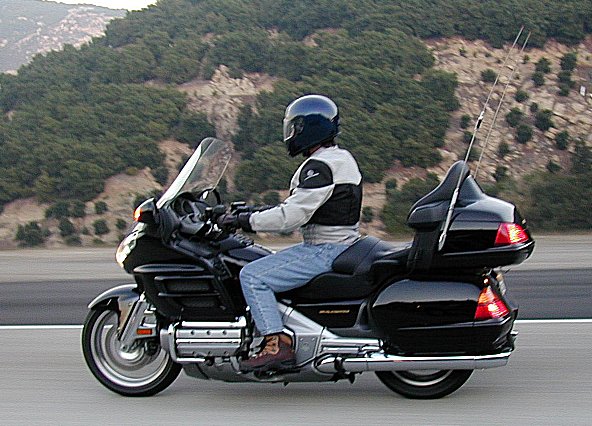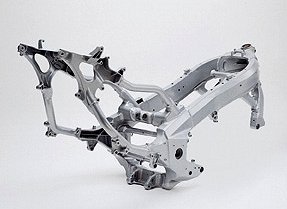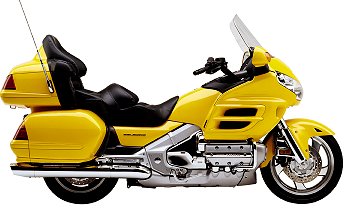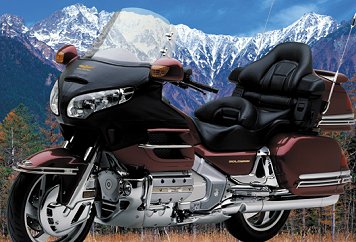Read this article in conjunction with MD’s two prior Gold Wing reports dated November 20, 2000 and September 21, 2000.
When a major corporation undertakes the complete re-design of a “flagship” product, it is a very risky proposition. Dealing with a product that is already best-in-class, or, due to the recent emergence of a rival, close to it, is tricky. You can easily make a fundamental mistake that will alienate a large, loyal following.
Several years ago, Ford Motor Company re-designed its Taurus automobile — at a time when the Taurus was at or near the top of the sales charts in the critical “Family Sedan” segment. Ford blew it. Despite its vast resources, and a clear understanding of the importance of the task at hand, Ford’s re-design of the Taurus missed the mark … badly. It can happen.
In motorcycling, Honda’s Gold Wing is a very special product, and not just to Honda. Beginning in the 1975 model year with the GL1000, Honda literally invented the luxury touring category, and, through constant development and refinement, reached a pinnacle in the 1988 GL1500 — a six-cylinder, 1500cc luxury tourer that reigned virtually without peer until the relatively recent emergence of BMW’s superb K1200LT.
Re-designing the GL1500 was undoubtedly a daunting task for Honda. It put at risk the fierce loyalty of a massive world-wide following. Did Honda blow it? No — far from it..
The 2001 Honda Gold Wing is a phenomenal motorcycle. Not good, not great — it goes beyond this. Honda enhanced virtually every strength of the GL1500 (with very few compromises), while simultaneously giving the GL1800 a new, performance personality. A performance personality that is so strong, it belies the GL1800’s residence in the Luxury Tourer category and promises to draw a whole new breed of rider — younger and more performance oriented — to the Gold Wing.

Mike Schroeder Wanted to Trade His GL1500 for the GL1800 — I Told Him Honda Already Had a Similar Museum Piece
I pride myself on my ability to competently test motorcycles from virtually every category, including off-road and motocross machines. For this test, however, I knew I owed it to MD’s readers to provide not only my perspective, but the perspective of an experienced GL1500 owner/rider.
Mike Schroeder makes his living in the Gold Wing “industry”. He is the owner of Simpro Products, a manufacturer of Gold Wing lighting accessories. He has also owned a GL1500 since 1988, and has put more than 136,000 miles on his personal Gold Wing since that time. Moreover, he has worked on, and ridden, virtually every GL1500 model since 1988, and spent some time as a Gold Wing mechanic at Huntington Beach Honda, a California dealership that specializes in Gold Wing sales and service.
Mike rode the GL1800 both during the daylight and at night. Before discussing his assessment, I will discuss some technical aspects of the GL1800, and my personal response to riding this new machine.
Honda chose an interesting engineer to put in charge of the GL1800 project. His name is Masanori Aoki. According to Honda, Mr. Aoki is a “sport bike guy”, and his credentials back this up. He was Large Project Leader (Honda’s phrase for chief engineer/designer) for several sport bikes, and even a roadracing machine, before being assigned to the Gold Wing project.
Honda clearly intended that its new Gold Wing be sportier. It had to handle better, have a more powerful and responsive engine, better braking, and sportier suspension settings.
Combining all this with lighter weight, and equal or better luxury performance and features, was a complex assignment. Fundamental design changes from the 1500 were necessary, and it was decided to go to a sport bike-like aluminum beam frame. A frame that is twenty-five pounds lighter than the old, steel frame, has far fewer parts, and, important from a sporting perspective, is much stiffer.
Several different engine displacements were considered by Honda, although it appears that Honda quickly decided to stick with the six-cylinder, flat, boxer-style motor of the previous model. Ultimately, customers surveyed by Honda preferred an 1800cc machine — and the production model displaces 1832cc.
With more power, and sporting performance in mind, Honda had to re-design the brakes and suspension. Larger, 45mm forks grace the front end of the new Gold Wing, and include a new anti-dive system designed to work with Honda’s Linked Braking System (“LBS”). Three-piston calipers squeeze two 296mm front discs and a single 316mm rear disc.
Somewhat surprisingly and perhaps reflecting Mr. Aoki’s sport bike background, Honda went with a single-side swing arm in the rear. Honda’s Pro Arm system employs technology to reduce unwanted torque effects from the drive shaft. The single shock absorber incorporates an electrically controlled spring pre-load adjuster that is easily operated by the rider, to compensate for differing passenger and luggage loads.
Honda is well aware of the desire of many Gold Wing owners for long-lasting tire performance. New tires (Bridgestones) were designed to compliment the Gold Wing, and the goal was both improved performance and maintaining long-wearing characteristics. Front tire size is unchanged, but the rear tire has gone from a width of 160mm to 180mm, largely to handle the higher torque output of the new motor.
Honda also wanted to move the Gold Wing’s styling in a sportier direction. In person, the new Gold Wing has an almost European look about it, and the mechanical aspects of the machine are deliberately more visible.
In an effort to maintain similar fairing coverage for the rider, and to enhance steering feel, and passenger space, the riding position on the new Gold Wing is 50mm closer to the fairing and windshield than the old model. This allowed the new fairing to be smaller — reducing aerodynamic drag by a significant ten percent. Additionally, two more inches of seating room for Gold Wing passengers was created.
The luxury features available on the Gold Wing, not surprisingly, are extensive. Highlights include an all-new electronic reverse system that operates with a single push button on the handle bar, a new cruise-control system that responds forty percent more rapidly than last year’s model, re-designed luggage with 147 liters of storage — operated by a remote control key-lock system, and a significantly upgraded audio system with an optional 6 CD changer.
Fuel capacity was increased to 6.6 gallons in the new Wing.
With the aging of the customer profile of the GL1500, Honda had no choice but to move the GL1800 in a direction that would be appealing to younger riders. At the same time, Honda did not want to alienate its traditional, core Gold Wing customer base. This was a balancing act — one that Honda ultimately performed well.
Riding the GL1800 is a revelation. I have ridden virtually every high-performance sport bike manufactured in the last few years, including Yamaha’s incredible R1, Honda’s own CBR929RR, and others. State-of-the-art handling in a motorcycle is something I have become quite familiar with. Despite this, I was literally shocked by the handling of the new Gold Wing.
When you understand that a bike weighs nearly 800 pounds (and you have been riding machines that weigh less than 400), with all of the luggage capacity and amenities of the new Gold Wing, your expectations for the handling are biased toward “slow and lumbering”.
During my first ride, before reaching the freeway approximately 15 minutes from my start, the quickness of the steering of the new Gold Wing took me off guard, somewhat. This is not a lumbering, luxury tourer. Its responses, both around corners and in quick lane change maneuvers, are decisive and controlled. At the same time, the machine exhibits excellent stability, both in a straight line and through long, sweeping turns. Amazing.
Interestingly, Mike’s response to the handling was similar to my own. After his first ride, his first words to me were “I don’t know how to compare this bike to the older model.” The handling improvement is that significant. He described the new machine as “wanting to go into corners”, rather than resisting. He said the steering input required was much lighter, but the machine held a line really well through corners, and the handling was very predictable. Overall, Mike described the handling of the new machine as “outstanding”. In fact, he said, the handling was superior to the Honda ST1100 sport tourer he had acquired a couple of years ago (by the way, the foot peg feelers are the first things to touch down in the corners, giving the rider a relatively benign reminder).
The next thing that strikes you about the new Gold Wing is its engine performance. I will go straight to Mike’s comments in this category. He described the new motor as “far superior to the 1500”. More than once, he told me that the performance increase was far greater than the additional 300cc would lead you to expect. Throttle response was improved significantly. Compared to the old Gold Wing, the rider had much more feel from the engine. The old machine, by contrast, largely isolates the rider from engine feel. Nevertheless, the new engine was smooth and in no way bothersome to the rider.
Part of Honda’s goal was to make the Gold Wing rider more involved with the machine. Making the engine a rigidly-mounted, stressed member of the new frame is one step Honda took toward this goal.
The new engine gives the Gold Wing astounding acceleration. It is my understanding that the GL1800 accelerates quicker than the Valkyrie, for instance, and my seat-of-the-pants assessment indicates high 11s in the quarter mile. Although, once again, smooth and predictable, the GL1800 quite simply hauls ass!
The new machine has a higher red line than the 1500. 6,000 rpm versus 5,500 rpm. At 70 mph on the highway, the GL1800 is turning 3,000 rpm in top gear. At 60 mph, it is turning 2,500 rpm. In Europe, on the autobahn, the GL1800 will cruise easily at 120 miles per hour, and should easily reach red line in top gear (at 140 miles per hour).
Acceleration is outstanding at virtually all engine speeds above 1,500 rpm. This motor is extremely flexible and freely revs to 6,000 rpm. Indeed, as I was getting used to the bike, I bounced the tach off the rev limiter more than once.
The massive torque, and adjustable suspension, make the machine feel almost unaffected by passenger and luggage load — another Honda design goal. For example, I put my 200 pound neighbor on the back of the bike (on top of my 200 pound rider status), and took the Gold Wing through a twisty, familiar road – hard on the throttle — hard on the brakes — turn — repeat. Although you certainly notice the higher center of gravity with a passenger this large, by pumping up the rear preload (there is a 20 stage adjustment available), I was able to maintain the GL1800’s excellent handling balance, and the motor and the brakes were virtually unfazed by the additional weight.
Honda now has years of experience with its Linked Braking System (LBS). The new Gold Wing’s brakes (again, in Mike’s words) are “fantastic”. My own reaction was similar. With the enhanced road feel and the immense power of the Gold Wing’s braking system, I had great confidence braking from high speeds, and even trail braking (normally, a sport bike technique) into corners.
I am not a big fan of linked braking (I like to make my own choice about which brake to apply and with what pressure), but on the GL1800, the system works so well I can’t help but be impressed. The GL1800, even when combined motorcycle, rider and passenger weight approached 1,300 pounds, stopped with almost no fork dive (a combined benefit of the anti-dive mechanism in the fork and the LBS), great power and control. The braking performance of the GL1800 ranks right up there with the high standards set by its handling and engine.
I deliberately ran two tanks of gas through the GL1800 in different modes — one tank while riding the machine mercilessly hard, and another tank at a more normal, relatively sedate pace. During both fuel loads, I combined a significant amount of highway time with a smaller amount of around-town street riding — trying to emulate the typical Gold Wing rider.
The aggressively ridden tank of gasoline returned 32 miles per gallon, while the more normally ridden, relatively sedate tank returned 40 miles per gallon. Despite the increased engine performance, Honda understood clearly that Gold Wing riders want good gas mileage, and this goal seems to have been achieved, as well. The more carefully monitored and sophisticated metering of fuel in the new machine seems to deserve the credit here.
Compromises versus the GL1500 design? There are a few. According to Mike, there is slightly more air buffeting on the rider’s legs (reflecting the smaller fairing lowers) and upper arms on the GL1800. The handlebar position is lower and sportier — perhaps, sacrificing some comfort for some riders. Mike preferred the new handlebar position, however, and had actually lowered the bars on his 1500.
Suspension compliance is excellent, but the machine purposely transmits more road feel to the rider. This is a plus if you are looking for higher handling limits, but can be a negative if you like the isolated ride that traditionally defined luxury touring. Just like Lincoln automobiles, Honda has moved beyond this type of handling at the risk of alienating some of its older customers. Nevertheless, Mike described the bump absorption as good — “You can just feel what the tires are doing, now.”
After riding dozens of sport bikes and dirt bikes in the last few years, and after a lifetime of focusing on performance motorcycles (during which I raced amateur motocross), I was very pleasantly surprised — shocked even — by the performance of the new Gold Wing. The traditional Gold Wing owner/rider will have a similar reaction — Mike verified this. Mike’s bottom line? The new GL1800 has an awesome motor, but the improvement in the handling is the most striking difference from the GL1500.
Honda undertook the delicate task of completely re-designing, from the ground up, an icon in the motorcycling industry. Employing its vast resources to apply careful engineering, testing and market analysis, Honda aimed to move the GL1800 to a new, younger audience looking for more riding excitement — without sacrificing the luxury and convenience afforded by the GL1500. The target was an elusive one. The result? Bull’s Eye.











